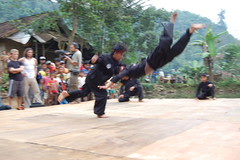Rembrandt Harmenszoon van Rijn (July 15, 1606 – October 4, 1669) was a Dutch painter and etcher. He is generally considered one of the greatest painters and printmakers in European art history and the most important in Dutch history. His contributions to art came in a period that historians call the Dutch Golden Age.
Rembrandt, role-playing in Self-portrait as an
oriental Potentate with a Keris, etching, 1634
Rembrandt being a Dutch artist during the time of Dutch presence in the South East Asia through the Dutch East India Company (V0C), is also a collector of exotic artifacts such as the Keris, which lend picturesque credibility to his biblical subjects like The Blinding of Samson. Using a Keris to puncture Samson's eyes probably shows his fascination with the exotic looking Silat weapon.
It is an interesting fact to know that a Silat weapon is admired and owned by a great painter such as Rembrandt. So, I had to own this book titled The World Encyclopedia of Knives, Daggers & Bayonets by Dr Tobias Capwell. The sad thing is, I as a Malay and a practitioner of a Silat, has yet to own one myself, this Malay dagger called the Keris.
According to my teacher, Guru Jak, the Keris is used more as a weapon of duel by the Malay noblemen, instead of as a weapon of war. I have a very little knowlege on how to use the Keris as a weapon and the only opportunity I had to learn was during the shooting of the documentary Inside Silat : Weapons of Destruction which one of its segments is on the Keris. It was based on Silat Hulubalang Melaka at Gelanggang Anggerik Jingga in Melaka and thought by a Silat World Champion of the 80s, Guru Eddy. Very different to the system that I am learning and hard for me to grasp as I have no prior experience in handling this weapon.
Later in the evening, I went to Suria KLCC mall and stopped by the Galeri Petronas where they are showcasing the artwork by one of Malaysia's foremost contemporary sculpture, Raja Shariman. The show is called Rhythm of the 21st Century - Monologues of Raja Shahriman. It is his sixthe solo exhibition and his largest to date, bringing together 20 new large-scale sculptures, 25 drawings and 15 paintings in a compelling show that symbolizes the destructive nature of man.
Alang Durjana by Raja Shahriman
A very productive artist I would say. Besides the elements of ammunition and twisted black metal in humanoid form being violent and destructive in nature, elements of Silat such as the Sikap Pasang and Keris are obvious in many of his sculptures. Another thing that I noticed is a number of his works are titled after the conflicts that occurred and is still occurring in the Muslim world. So I would conclude that his artworks are closely tied to his identity as a Malay and a Muslim. As I was doing some research on his work, I stumbled upon his series called Gerak Tempur, which are really compelling to me. Must find out more about this artist. I think I met him once before, in a tribute to A. Samad Said show.
If you happen to be in Suria KLCC, stop by the Galeri Petronas to see his amazing work. The exhibition is open to public until 24 January 2010 from 10.00 am – 8.00 pm. Admission is free.
Salam.







